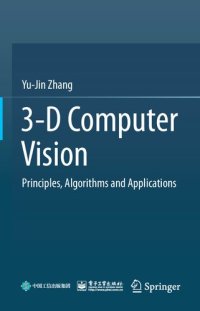
Ebook: 3-D Computer Vision: Principles, Algorithms and Applications
Author: Yu-Jin Zhang
- Genre: Computers // Algorithms and Data Structures: Image Processing
- Year: 2023
- Publisher: Springer
- Language: English
- pdf
This textbook offers advanced content on computer vision (basic content can be found in its prerequisite textbook, "2D Computer Vision: Principles, Algorithms and Applications"), including the basic principles, typical methods and practical techniques. It is intended for graduate courses on related topics, e.g. Computer Vision, 3-D Computer Vision, Graphics, Artificial Intelligence, etc.
This book mainly covers the higher level of computer vision from the selection of materials. This book is self-contained, mainly for information majors, but also takes into account learners of different professional backgrounds, and also considers the needs of self-study readers. After learning the fundamental content of computer vision in this book, readers can carry out scientific research and solve more and even difficult specific problems in practical applications.
This book pays more attention to practicality in writing. Considering that computer vision technology has been involved in many professional fields in recent years, but many working people are not specialized in computer vision technology, this book does not emphasize the theoretical system too much, minimizes the formula derivation, and focuses on commonly used techniques. This book has many sample questions and uses intuitive explanation to help readers understand abstract concepts.
This book can consider three aspects from the knowledge requirements of the prerequisite courses: (1) Mathematics: including linear algebra and matrix theory, as well as basic knowledge about statistics, probability theory, and random modeling; (2) Computer science: including the mastery of computer software technology, the understanding of computer structure system, and the application of computer programming methods; (3) Electronics: On the one hand, the characteristics and principles of electronic equipment; on the other hand, circuit design and other content. In addition, the book 2D Computer Vision: Principles, Algorithms and Applications can be counted as the discipline prerequisite of this book.
Computer vision began to be studied as an Artificial Intelligence problem, so it is often called image understanding. In fact, the terms image understanding and computer vision are often mixed. In essence, they are connected to each other. In many cases, they have overlapped coverages and contents, and they have not absolute boundary in concept or practicality. In many occasions and situations, although they have their own emphasis, they often complement each other. Therefore, it is more appropriate to regard them as different terms used by people with different professions and backgrounds.
This book mainly introduces the three-dimensional part of computer vision and also corresponds to the basic concepts, basic theories, and practical techniques of high-level image engineering. Through the comprehensive use of these theories and technologies, various computer vision systems can be constructed to explore and solve practical application problems. In addition, through the introduction of the high-level content of image engineering, it can also help readers to obtain more information based on the results obtained from the low-level and middle-level technologies of image engineering, as well as combine and integrate the technologies at all levels.
This book mainly covers the higher level of computer vision from the selection of materials. This book is self-contained, mainly for information majors, but also takes into account learners of different professional backgrounds, and also considers the needs of self-study readers. After learning the fundamental content of computer vision in this book, readers can carry out scientific research and solve more and even difficult specific problems in practical applications.
This book pays more attention to practicality in writing. Considering that computer vision technology has been involved in many professional fields in recent years, but many working people are not specialized in computer vision technology, this book does not emphasize the theoretical system too much, minimizes the formula derivation, and focuses on commonly used techniques. This book has many sample questions and uses intuitive explanation to help readers understand abstract concepts.
This book can consider three aspects from the knowledge requirements of the prerequisite courses: (1) Mathematics: including linear algebra and matrix theory, as well as basic knowledge about statistics, probability theory, and random modeling; (2) Computer science: including the mastery of computer software technology, the understanding of computer structure system, and the application of computer programming methods; (3) Electronics: On the one hand, the characteristics and principles of electronic equipment; on the other hand, circuit design and other content. In addition, the book 2D Computer Vision: Principles, Algorithms and Applications can be counted as the discipline prerequisite of this book.
Computer vision began to be studied as an Artificial Intelligence problem, so it is often called image understanding. In fact, the terms image understanding and computer vision are often mixed. In essence, they are connected to each other. In many cases, they have overlapped coverages and contents, and they have not absolute boundary in concept or practicality. In many occasions and situations, although they have their own emphasis, they often complement each other. Therefore, it is more appropriate to regard them as different terms used by people with different professions and backgrounds.
This book mainly introduces the three-dimensional part of computer vision and also corresponds to the basic concepts, basic theories, and practical techniques of high-level image engineering. Through the comprehensive use of these theories and technologies, various computer vision systems can be constructed to explore and solve practical application problems. In addition, through the introduction of the high-level content of image engineering, it can also help readers to obtain more information based on the results obtained from the low-level and middle-level technologies of image engineering, as well as combine and integrate the technologies at all levels.
Download the book 3-D Computer Vision: Principles, Algorithms and Applications for free or read online
Continue reading on any device:

Last viewed books
Related books
{related-news}
Comments (0)